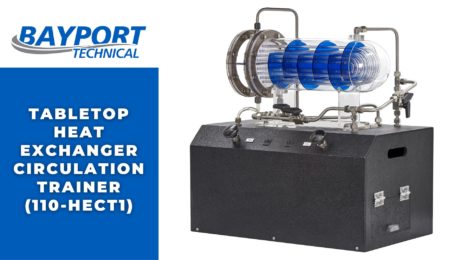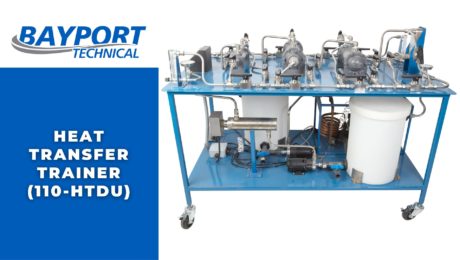Bayport Technical’s Tabletop Trainer Gives Users an Introduction to Heat Exchangers
A wide variety of industrial processes require the transfer of heat from one fluid (liquid or gas) to another. Most mechanical and chemical systems use heat exchangers to accomplish this task. In a heat exchanger, the two fluids do not make direct contact. Instead, heat passes from the hotter fluid to the metal isolating the fluids and then to the cooler fluid.
Common industrial applications that utilize heat exchangers for heat transfer include heating, ventilation, and air conditioning (HVAC) systems; preheaters or coolers in fluid systems; radiators on internal combustion engines; and boilers, evaporators, and condensers used with fluids like oils, wastewater, hydrocarbons, biogases, etc. in industries such as oil and gas refining and power generation.
Given the range of applications, you’ll find heat exchangers in many different shapes, sizes, and designs. The most common and basic type is the shell and tube heat exchanger, which consists of a set of tubes inside a cylindrical shell. Fluids flow inside the tubes (tube-side fluids) and outside the tubes (shell-side fluids) and remain separated at the ends of the tubes by the tube sheets.
U-tube type heat exchangers are one of the most popular types of shell and tube heat exchangers. In a u-tube type heat exchanger, the tube bundle consists of continuous tubes bent into a “U” shape and secured to the shell by a tube sheet. The shape of the tubes directs fluid flow back and forth across the length of the heat exchanger, creating an inherent multi-pass design.
Because the bend side of the tubes is free floating in the shell, this design allows thermal expansion to occur without requiring expansion joints, meaning these types of heat exchangers can accommodate greater temperature differences than other designs.
Bayport Technical’s Tabletop Heat Exchanger Circulation Trainer (110-HECT1) features a hands-on circulation system designed to teach basic heat transfer knowledge. In addition to following the flow of two different colored fluids through the acrylic heat exchanger shell and tubes, this transparent training tool allows the user to completely dismantle and reassemble the unit in the classroom to see what each component looks like and how the gaskets are positioned.
The convenient, compact size of the Tabletop Heat Exchanger Circulation Trainer allows for ease of transportation between classrooms or use in multiple locations. The unit also features stainless steel valves for greater longevity and industrial realism.
Visit Bayport Technical’s website to learn more about the U-Tube Heat Exchanger Circulation Trainer with Backwash, as well as the wide variety of other technical training products available.
- Published in News
Bayport Technical’s Trainer Provides Hands-On Experience with Four Types of Heat Exchangers
A wide variety of industries use processes that require the transfer of heat from one fluid (liquid or gas) to another, and most of those systems use heat exchangers to accomplish this task. In a heat exchanger, the two fluids do not make direct contact. Instead, heat passes from the hotter fluid to the metal isolating the fluids and then to the cooler fluid.
You can find heat exchangers in all sorts of industrial applications, such as heating, ventilation, and air conditioning (HVAC) systems; preheaters or coolers in fluid systems; radiators on internal combustion engines; and boilers, evaporators, and condensers used with fluids like oils, wastewater, hydrocarbons, biogases, etc. in industries such as oil and gas refining and power generation.
Heat exchangers come in a wide variety of shapes, sizes, and designs. The most common and basic type is the tube and shell heat exchanger, which consists of a set of tubes inside a cylindrical shell. Fluids flow inside the tubes (tube-side fluids) and outside the tubes (shell-side fluids) and remain separated at the ends of the tubes by the tube sheets.
Another common type is the plate heat exchanger, which uses metal plates to transfer heat between the fluids. Plate heat exchangers are popular in applications that require heat transfer to occur as quickly as possible, because fluids get spread out over a larger surface area when they flow over the plates.
Bayport Technical’s Heat Transfer Trainer (110-HTDU) provides valuable hands-on experience with four different types of heat exchangers: brazed plate, brass single pass tube and shell, stainless steel single pass tube and shell, and four pass tube and shell.
The Heat Transfer Trainer features a wide variety of real industrial components, including: two pumps for hot and cold fluid, manifolded with valving; a water heater with storage tank; a refrigerant-type water chiller with storage tank; flow meters and controllers; and digital thermometers.
Visit Bayport Technical’s website to learn more about the Heat Transfer Trainer, as well as the wide variety of other technical training products available.
- Published in News


